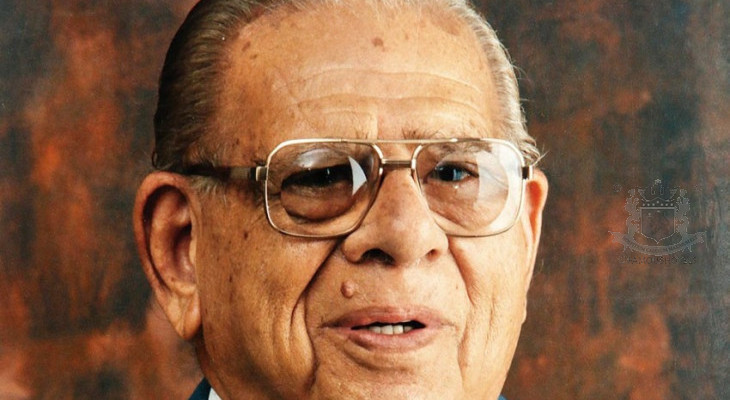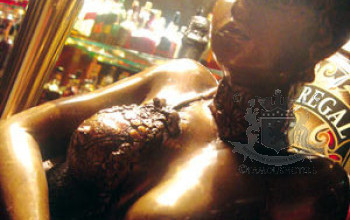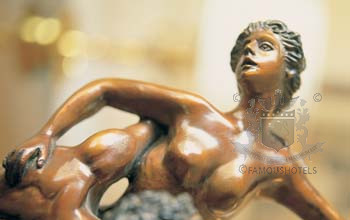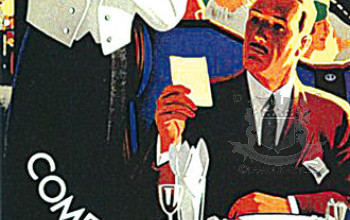Oberoi Mohan Singh
( words)
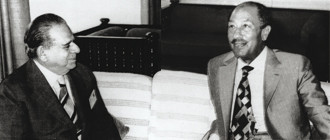
1972: M S Oberoi (left) meets president Sadat of Egypt (right) at the Mena House hotel in Cairo, Egypt. For both men the hotel was an object of prestige. Nasser needed a huge convention centre with a world class hotel attached to it. For Oberoi, Mena House was like the old Grand in Calcutta: a gem. He would make Mena House a landmark in restoration. A substantial sum would have to be spent to restore the hotel. Oberoi could not pitch in with any capital, but guaranteed a six per cent return on investment to the owning company Upper-Egypt Hotel Company and EGOTH – The Egyptian General Company for Tourism and Hotels.
Early Years of Mohan Singh Oberoi
1900: Mohan Singh was born on 15 August 1900. He grew up in Bhaun, a small city of some 8,000 inhabitants in Punjab, now in Pakistan. At 14 MS went to the Dayanand Anglo Vedic (DAV) School in Rawalpindi, chosen by his mother for its balanced mix of tradition and modernity. In Rawalpindi he saw two firsts: the first Englishman and the first hotel, Flashmans.
1901: Death of MS’s father, a 20 year old Sikh by the name of Sardar Attar Singh.
1916: After passing his matriculation exam, MS went to law school in Lahore, where he moved in with the family of Sardar Singh, his father's brother. His uncle was the proprietor of a flourishing shoe-factory, which gave MS exposure to the world of production and business.
1918: Half way to his bachelor’s degree, MS decided to abandon his studies in order to work in his uncle’s factory. Although initially not supportive of the move, MS’s uncle offered him a managerial position. However, times in India were uncertain and MS’s early career fell victim to wave the unrest and protest that was spread across the subcontinent.
1919: The shoe factory shut down after people were shot in Amritsar, causing widespread chaos.
First steps in the hotel trade
1920: At the age of 20 MS returned home and married the 15 year old Ishran Devi. Shortly after the wedding the shoe factory reopened and MS was eager to get back to Lahore. He burnt his bridges, however, by shaving off his beard, which offended his Sikh family and put an end to any chance of working for his uncle again. More woe followed when an epidemic broke out in Bhaun and MS was forced to flee along with his wife and small daughter. He arrived in Simla, where managed to get a 50 rupee-per -month job as a clerk at Faletti’s Cecil Hotel. At first his brief was to keep track of the hotel’s coal supplies and other deliveries of goods. Quickly impressing, he climbed to the position of guest clerk.
1923: MS was a quick learner, grasping social nuances as well as the nitty-gritty of hotel management and he could not have found better role models than the privileged guests of Cecil’s. He took on the responsibility of cashier.
1924: Birth of MS’ son Tilak Raj, TR (Tikki). By then MS was earning 60 rupees a month. 1927: Ernest Clarke, then manager of the Cecil Hotel, was offered a 1 year contract to manage the Delhi Club and asked MS to come along and join him there. MS accepted. It was a reckless decision, leaving an established chain for an uncertain future, but he had faith.Clarke’s Hotel, Simla.
1929: Birth of MS’s second son Prithvi Raj Singh, PRS (Biki). That same year, MS followed Clarke to the run-down 50-room Carlton in Simla. Clarke leased it from the bank for 9,000 rupees a year and renamed it Clarke’s Hotel.
1930: On March 17 1930 MS was made a partner at Clarke’s. He convinced Clarke to buy out the property instead of leasing it. They bought the hotel for 135,000 rupees, some 40,000 rupees less than the it was worth. The Delhi contractor Sardar Bahadur Narain Singh (who built The Imperial in Delhi) agreed to loan the money, if the property was mortgaged in the name of his son Jagjit.
1931: Occupancy of Clarke’s had doubled to 80 % since the takeover. MS was advertising: “Under European Management”. But debts were mounting too as the lease of the Carlton had also come with the struggling Grand Hotel in Delhi. Ernest and Gertie Clarke usually spent the winter in Delhi, while MS and his cousin Partap Singh Dhall were in charge of the Simla hotel.
1933-34: Ernest Clarke was in big financial trouble and MS had to come up with a plan to save the hotels. Clarke died shortly after and MS bought his shares from his widow for 20,000 rupees, loaning the money from a relative, Rai Bahadur Kapur.
1934: On 14 August MS became the sole proprietor of Clarke’s Hotel Delhi and Simla. That day he said to his daughter Rajrani: “Just wait, bitti, when you grow up, wherever you go there will be an Oberoi Hotel.”
Grand, Calcutta
1936: Having paid back all the loans on Clarke’s, MS was by chance offered the Grand in Calcutta, which had belonged to the Armenian real estate tycoon Stephen Arathoon and was in a state of decline.
1937-8: MS negotiated with the Mercantile Bank, liquidators of the estate of Stephen Arathoon, for a reduction of the Simla hotel lease. One condition was that a European manager should be appointed so MS brought in his former employer at the Cecil, DW Grove. Also coming in were: Shiv Nath Singh, owner of the Palace Hotel, Karachi, Katchand Kapur and Dr Hari Ram. With 25,000 rupees each in a partnership of four, they formed Hotel Pvt Ltd in 1938. to take the management lease for the Grand. On Dec 21 1938 the hotel reopened for business.
1940: Rajrani, eldest daughter of MS, wedded Colonel JC Kapur, nephew of Kahnchand Kapur at the Grand in Calcutta.1940-42: Profits were low and MS had to persuade his partners not to pull out of their investment by promising that not only would he share the profits but also singly bear all losses. Meanwhile, the war came to Calcutta, which along with Kandy, Ceylon became a centre of operations for the eastern theatre. Tens of thousands of men arrived en route to battles in Burma, the Philippines and Singapore. Ironically, this influx saved the Grand.
Rai Bahadur & The Imperial, Delhi1943: MS was presented with the title Rai Bahadur (pater familiae) by His Majesty the King. That same year, MS annexed the Associated Hotels of India chain and rented Delhi’s Hotel Imperial.
1944: At The Imperial, MS installed the custom of having a tall, stately Sikh doorman, in the full regalia of a viceregal bodyguard. A new menu was introduced into Oberoi hotels, including mince cutlets, custard cream, charcoal grill and the flambé at the Imperial’s Tavern. Delhi got its very first pasta, minestrone and pizza (now Punjabi pizza with chaat masala).Also that year, MS’ daughter-in-law Leela, who was in Paris for medical treatment, searched for a new French chef for The Imperial. After looking at Monsieur Gateau, chef of the Meurice Hotel, she finally chose Roger Moncourte. “Madame, I don’t care about le salaire, but I must have good cooking wine,“ he said upon accepting the job.
1947: MS bought out the property of the Grand for 89 lakh rupees, then paid off Kapur, Dr Rim and finally Shiv Nath.
Oberoi Expansion1947: The Oberoi Palm Beach opened.1948: Tikki and his friend Ripu Bhagat set up a travel agency, Mercury Travels. Tikki quickly lost interest so his sister Swaraj and her husband Gautam Khanna took over the business.
1949: On 26 May MS floated The East India Hotels Ltd (EIHL), named after the East India Company. Associated Hotels of India merged with EIHL. Although the company was public, there were just a few subscribers: Oberoi himself, his son Tilak Raj, Motilal Khaitan, Ripu Bhagat, N Haksar, E Brett and Man Singh. It would not go truly public till 1956.
1950 Gautam, son of Savitri Khanna, fell in love with Oberoi’s daughter Swaraj. MS could spot a human being’s potential as well as he could a hotel’s. He asked him to join his family and soon his business. He would later become Biki’s right hand man.
1951 MS bought the second Arathoon hotel in Darjeeling, the 65 room Everest Hotel.1952: The partnership of Hotel Pvt.Ltd, founded in 1938, was dissolved. That year also saw the Oberoi family embark on an around-the-world tour stopping at Paris, London, NY etc… and staying at the most exclusive hotels such as the George V, Dorchester, and Waldorf. For MS it was a fact-finding mission.Mid-50s: The Oberois moved from Calcutta to Delhi. The family moved into Maidens while Tikki set himself up in a lavish suite at The Imperial.
1955: MS took his first trip to Kashmir / Srinagar. For a fee of 5,000 rupees per month for 20 years, he bought the former Palace of the Maharajah Hari Singh, who had abdicated in favour of his son. The palace had been empty for a decade. It had a billiards room, a gun room, dozens of bedrooms and drawing rooms, grand audience halls, but just 10 bathrooms, some without doors. Oberoi bought back the whole furniture.That same year, Biki returned home from his studies in London and his master courses in haute cuisine at Lausanne.
1956: MS bought the Swiss Hotel opposite Maidens. It had once been the residence of Lord Curzon, was now owned by the Chunamals, an old Delhi family and leased by them by Steiner, formerly Associated Hotels. That year also saw the wedding of Tilak Raj Oberoi and Leela Naidu on 16. July. He was 33, she 17. Her father was a nuclear physicist, Science Director for UNESCO for South East Asia.
1957: MS’s youngest daughter Prem married Captain KK Mehra.
1958: Dispute at The Imperial over money:
MS rented out every corridor to shops at the hotel, making more money per shop than he needed to pay for the lease of the whole hotel. The landlord Saradar Bahadur took him to court and reclaimed the hotel, demanding that it be given back in the same state Oberoi had received it. MS removed everything: linen, cutlery or porcelain, carpets, furniture, paintings, chandeliers as well as bathroom fittings – the marble cladding, the toilets and the air-conditioning ducts. This brought the Oberoi period at The Imperial to an end.
1959: Biki married Goodie, the daughter of a Punjabi landowner of Lyalpur.
1964: Tikki proposed to the Teuton daughter of Ludwig Mittel Huber, the blonde Jutta. Tikki was a polo playing prince with a royal lifestyle.
1965: Tikki and Jutta’s son Arjun was born. Oberoi’s dream hotel, Intercontinental Hotel, opened. Unfortunately it coincided with the first Indo-Pakistan war.
1966: MS wanted to build a new 34 or 36 storey hotel and found a suitable plot of (expensive) land in Bombay. He entered into cooperation with ITT Sheraton. It was a project of great scale: the longest lobby in India, and ebony black Watco oil -finished wood. The design consultant was Dale Keller & Associates. Also that in ’66, Oberoi started a hotel management school in India. The Intercontinental’ F&B manager Sven Jorgensen was in charge of the school. It germinated at the Imperial Hotel, grew at the Intercontinental and then flourished into a sprawling institution at Maidens. Thousands applied for the 300 seats every year straight out of college.
1969: Oberoi took over his organisation’s first international venture: the Kathmandu Soaltee Hotel in Nepal, owned by Prince of Himalaya, the uncle of King Mohendra. Thus the Oberoi Group became an exporter of know-how at a time when India was not considered an expert in any entrepreneurial area. In December 1969 the Oberoi Soaltee opened. That same year, Oberoi took over the management of Singapore’s Imperial Hotel, where the first Oberoi Intercontinental manager William Land was working. The hotel was in a mess. It would stay under Oberoi until 1986.
1970: The Indian Government insisted that MS take up a project in Zanzibar, to complete a hotel for the island’s National Day. The Oberoi Group had no saying in the building of the structure. MS made an honourable retreat as soon as he could. Indeed, Africa remained an impenetrable area for the chain, as did Latin America.
Mena House
1971: After a trip to London, Gautam Khanna stopped off in Egypt to scout business opportunities. On an excursion to the Pyramids in Giza, he stumbled on the dilapidated Mena House – an institution that was to hotel keeping what the Orient Express was to trains. MS travelled to Egypt immediately and found Mena House to be just like the old Grand in Calcutta and Gulab Bhawan in Kashmir. Mena House was owned by the Upper Egypt Company which had taken over the nationalized hotel from its previous Jewish owners, the Nungovich Company. One evening MS was introduced to Amr el Alfi, Egypt’s leading architect interior decorator, who put him in touch with the Minister of Tourism, Zaki Hashmi. A substantial sum of money would need to spend to restore Mena House to its former glory. Oberoi could not pitch in with any capital, but guaranteed a six per cent return on investment to the hotel’s owners. The new Elephantine Hotel in Aswan was also part of the deal.MS handpicked Rattan Tata, one of the brightest sparks in the Oberoi group from Singapore’s Imperial, to front the Mena House operation.
1972: The Oberoi Sheraton Bombay was ready to be opened to the public. In December, the first tourist group to arrive were Japanese. Meanwhile, at Mena House, Rattan Tata introduced the country’s first discotheque, the Saddle. Mena House was also the chosen venue for the Egypt-Israel talks, following an war Sadat’s peace initiative.
International Expansion
1972: Mena House was an “open sesame“ to the Arab world. Negotiations for the Baghdad Al Rashid Hotel began in the 1970s when Iran & Iraq were already at war. Oberoi would take on the management for 5 years, till Saddam Hussein decided that a foreign group running a hotel where state guests stayed did not quite gel with national pride. The group retained a presence at the Oberoi Babylon, on the banks of the Tigris.
1973: On April 7 the Oberoi Sheraton in Bombay officially opened. The cost of the project had risen from the initial estimate of 70 million rupees to 180 million rupees.
1973: Oberoi began building his first hotel outside India: the Lanka Oberoi. It was an Atrium design by the Armenian Group of Skidmore, Owings and Merrill. At that time the Hyatt in Atlanta was the only other hotel featuring this concept. 1975: The Lanka Oberoi opened.
1976: The Windsor in Melbourne came into Oberoi’s sights. Dating from the 1880s, it had become something of a white elephant to its owners. The Australian government had taken over the hotel until Rai Bahadur, then 80 years old, won the bid to lease it for two years with an option for 20 more. Australia’s worst racism surfaced. “The Windsor goes to an Indian,” howled the press.
1977: A cooperation begun between Oberoi and the Arab Sheik Ali Tanuimi.
1978: The Bali Oberoi opened its doors.
1980: Unveiling of The Windsor Jewel in the Oberoi Crown. That same year, Ratan Tata moved to Dhahtan to head a company called Saudi Oberoi.
1981: The first achievement of Ratan Tata’s Saudi Oberoi company was the Dammam Oberoi - 300 rooms, 40 suites: the finest hotel in the Gulf Kingdom.
1984: Death of Tikki. Cecil’s closed down.
1985: Egypt presented Rai Bahadur with its coveted Order of the Republic – First Class award: two massive stars of gold for having promoted modern tourism in the ancient land of Misr. 1986: MS withdrew Oberoi from the management contract of The Imperial in Singapore.
1987: Biki spotted a European property in Budapest. The only problem was it happened to be the headquarter of the secret police.
1991: Oberoi signed the agreement for the Oberoi Gresham Palace in Budapest. Unfortunately things went wrong and the hotel ultimately opened as the Four Seasons Grisham Palace in 2004.
1988: On November 2 Ishran Devi died.
2002: MS Oberoi passed away, leaving a massive legacy to his family and to the world of hospitality.
2009: Irishman Liam lambert becomes CEO of the Oberoi Group.
2012: The Clarkes Hotel, after remaining temporarily shut following its lawns caving in because of construction in the eco-sensitive vicinity, reopened on 16 September 2012
2018: Mena House leaves the Oberoi Group (>>> Marriott)
2021: Prithvi Raj Singh Oberoi (executive chairman), Vikramjit Singh Oberoi (MD & CEO), Arjun Singh Oberoi (MD Development)
The company currently manages 33 hotels under the luxury brand Oberoi Hotels & Resorts, with a further 10 five-star properties under the Trident Hotels brand. The group also operates the Clarkes Hotel in Shimla and the Maidens Hotel, Delhi (another Select Member of The Most Famous Hotels in the World). However, these two properties are not held under the Trident or under the Oberoi brand.
++++++++++

